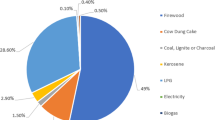Abstract
In this paper, the results of indoor radon levels in the spas of Bosnia and Herzegovina, which became known as health institutions, are presented. With the method of solid state nuclear track detectors (SSNTD) type CR-39 the measurements of radon activity concentration in the air in spas of Bosnia and Herzegovina were performed. The results of measurements have shown that the values of radon activity concentrations at the investigated spa locations were in the range 6.5–168.4 Bqm−3. The estimated annual effective dose was in the range 0.04–0.97 mSvy−1 and 0.40–10.20 µSvy−1 for workers and patients, respectively. For all investigated spas excess lifetime cancer risk (ELCR) and dose equivalent were estimated.





Similar content being viewed by others
References
Durani S, Ilić R (1997) Radon measurements by etched track detectors: application in radiation protection, earth sciences and the environment. World Sci Publ Co Ltd, London
World Health Organization (2009) WHO handbook on indoor radon: a public health perspective. WHO, Switzerland
Khalid N, Majid AA, Yahaya R, Yasir MS (2014) Radiological risk assessment of environmental radon. AIP Conf Proc 1571: 169–176
Sabol J, Weng PS (1995) Introduction to radiation protection dosimetry. World Sci Publ Co Pte Ltd, Singapore
Slivka J, Bikit I, Vesković M, Čonkić LJ (2000) Gama spektrometrija, specijalne metode i primene [Gamma spectrometry, special methods and applications]. University of Novi Sad, Novi Sad (In Serbian)
National Research Council (US) Committee on Risk Assessment of Exposure to Radon in Drinking Water (1999) Risk assessment of radon in drinking water. National Academy Press, Washington (DC)
Cozma AI, Moldovan M, Baciu C, Burghele B (2014) Radon and radium monitoring in several groundwaters from Rosia montana area, Romania. In: Ristić G (ed) Proceedings of second east European radon symposium, May 27–30; Niš, Serbia. Niš: University of Niš, Faculty of Electronic Engineering, pp 9–12
Nowak J, Dinh CN (2017) Radon as a potential health hazard for clients and workers of selected thermal spas in Poland. Radiat Prot Dosim 175(3):373–377
Duran SU, Kucukomeroglu B, Cevik U, Celik N, Taskin H, Ersoy H (2019) Radioactivity in spas of Black Sea region, Turkey. Int J Radiat Res 17(3): 391–399
Nikolov J, Todorović N, Bikit I, Pantić TP, Forkapić S, Mrđa D, Bikit K (2014) Radon in thermal waters in south-east part of Serbia. Radiat Prot Dosim 160(1–3):239–243
Nikolov J, Todorovic N, Pantic TP, Forkapic S, Mrdja D, Bikit I, Krmar M, Veskovic M (2012) Exposure to radon in the radon spa Niška Banja, Serbia. Radiat Meas 47(6): 443–450
Silva AS, Dinis ML (2017) Variability of indoor radon level accumulation: a study in Portuguese Thermal spas. In: Ristić G (ed) Proceedings of RAD 2017 conference, the fifth international conference on radiation and applications in various fields of research, June 12–16; RAD Centre, Niš, Serbia, vol 2, pp 141–148
Shahrokhi A, Nagy E, Csordas A, Somlai J, Kovacs T (2016) Distribution of indoor radon concentrations between selected Hungarian thermal baths. Nukleonika 61(3):333–336
Labidi S, Al-Azmi D, Salah RB (2012) Indoor radon in Tunisian spas. Radioprotection 47 (3): 361–376
Radolić V, Vuković B, Smit G, Stanić D, Planinić J (2005) Radon in the spas of Croatia. J Environ Radioact 83(2): 191–198
Manic G, Petrović S, Vesna M, Popovic D, Todorovic D (2006) Radon concentrations in spa in Serbia. Environ Int 32(4): 533–537
van der Aa M (2003) Classification of mineral water types and comparison with drinking water standards. Env Geol 44: 554–563
European Council (2014) European Council Directive 2013/59/Euratom of 5 December 2013 laying down basic safety standards for protection against the dangers arising from exposure to ionising radiation, and repealing Directives 89/618/Euratom, 90/641/Euratom, 96/29/Euratom, 97/43/Euratom and 2003/122/Euratom. OJ EU L13 57: 1–73
United Nations Scientific Committee on the Effects of Atomic Radiation (UNSCEAR) (2000) Sources and effects of ionizing radiation. UNSCEAR 2000 Report, New York, vol I
Operta M, Hyseni S (2013) Thermal mineral waters in Bosnia and Herzegovina as well as the potential for tourism development. Int J Water Res 1(1): 25–29
RadoSys (2000) User manual, RadoSys Company, Hungary
International Commission on Radiological Protection (ICRP) (1979) Limits for intakes of radionuclides by workers. ICRP Publication 30 (Part 1). Ann. ICRP 2 (3-4)
International Commission on Radiological Protection (ICRP) (2007) The 2007 recommendations of the international commission on radiological protection. ICRP Publication 103. Ann. ICRP 37 (2–4)
International Commission on Radiological Protection (ICRP) (1993) Protection against Radon-222 at home and at work. ICRP Publication 65; Ann ICRP. 23(2)
Alghamdi AS, Aleissa KA, Al-Hamarneh IF (2019) Gamma radiation and indoor radon concentrations in the western and southwestern regions of Saudi Arabia. Heliyon 5(1):e01133
Kasić A, Adrović F, Kasumović A, Hankić E (2015) Levels of natural radioactivity in mineral and thermal waters of Bosnia and Herzegovina. Nukleonika 60(3):503–508
Spahić M, Temimović E (2014) Termomineralne vode Bosne i Hercegovine u funkciji balneološkog turizma [Thermomineral waters of Bosnia and Herzegovina in a function of balneological torism]. Acta geogr Bosn Herzeg 1(2):65–75 (In Bosnian)
Kavasi N, Kobayashi Y, Kovacs T, Somlai J, Jobbagy V, Nagy K, Deak E, Berhes I, Bender T, Ishikawa T, tokonami S, Vaupotič J, Yoshinaga A, Yonehara H (2011) Effect of radon measurement methods on dose estimation. Radiat Prot Dosim 145(2–3):224–232
Vaupotic J, Kobal I (2001) Radon exposure in Slovenia spas. Radiat Prot Dosim 97(3):265–270
Author information
Authors and Affiliations
Corresponding author
Additional information
Publisher’s Note
Springer Nature remains neutral with regard to jurisdictional claims in published maps and institutional affiliations.
Rights and permissions
About this article
Cite this article
Kasić, A., Kasumović, A. Indoor radon levels, dose and health risk assessments in spas of Bosnia and Herzegovina. J Radioanal Nucl Chem 331, 231–239 (2022). https://doi.org/10.1007/s10967-021-08098-9
Received:
Accepted:
Published:
Issue Date:
DOI: https://doi.org/10.1007/s10967-021-08098-9




